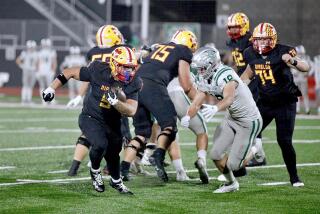BYU Gets Officially Snubbed
- Share via
Recapping Sunday’s alliance bowl selection ceremonies, Florida and Nebraska received rare second chances, 8-4 Texas earned a fat Fiesta Bowl check for $8.486 million--that averages out to more than $2 million per loss--and No. 5 Brigham Young got the proverbial you-know-what.
So how about this selection process?
Although rumors of a potential snub had been swirling for days, the maverick Western Athletic Conference officially became outraged Sunday when the 13-1 Cougars were bypassed for one of two at-large alliance openings.
“It defies logic,” WAC Commissioner Karl Benson said. “What if BYU was 14-0. Would somebody have taken them then? I don’t know.”
Because the WAC is not a member of the alliance, which consists of the Sugar, Fiesta and Orange bowls, BYU’s only chance for a major bowl bid was to secure one of two at-large picks.
The WAC had threatened legal action if BYU was not picked, and Benson said that remains a possibility, although he said the conference would defer any possible action until next year.
Privately, WAC officials said BYU is against pursuing legal recourse for religious reasons.
Short term, Benson said the WAC will push to have the current alliance rules altered so that a non-alliance team ranking No. 12 or higher would automatically receive an at-large berth.
Long term, the WAC will seek to reopen the possibility of a national college football playoff.
“We’ve asked the NCAA Presidents Committee to dust off the playoff proposal that was revealed two years ago and to take a look at it today under the current environment,” Benson said.
Sunday’s selection process went nearly as expected. The Sugar Bowl, with the first two picks, took No. 1 Florida State (11-0) and No. 3 Florida (11-1); the Fiesta selected No. 7 Penn State (10-2) and Texas with the third and fifth picks while the Orange paired No. 6 Nebraska (10-2) and No. 10 Virginia Tech (10-1) with the fourth and sixth selections.
Penn State and Nebraska were the at-large selections. The four other teams had automatic berths because they won their conference titles.
The Sugar Bowl pairing offered Florida a chance at redemption only eight days after the Gators thought they had blown their national title hopes with a 24-21 loss to Florida State.
Now, a victory over the Seminoles coupled with an Arizona State loss in the Rose Bowl would likely earn Gator Coach Steve Spurrier his first national championship.
“We didn’t think we’d be back in the Sugar Bowl after what happened a week ago,” Spurrier told the Associated Press. “But Texas upset Nebraska. Heck, we’re looking forward to the game. We’ll see if we can play a little better against them than the last time.”
In 1994, after playing to a 31-31 tie in the regular season, Florida lost a Sugar Bowl rematch against Florida State, 23-17.
In a mild surprise, Nebraska edged out alliance at-large candidates Colorado, Tennessee and BYU despite Saturday’s 37-27 loss to unranked Texas.
BYU had a higher poll ranking than four of the six alliance selections, but did not get an automatic berth because the WAC was not included in the alliance formed in 1994 to help pair the top two teams in a “national title” game.
Roy Kramer, alliance coordinator and Southeastern Conference commissioner, defended the system.
“Once the top game is picked, the alliance itself stays out of it and the integrity of the process is held up then by the bowls making those selections,” he said.
Sunday’s financial ramifications? Instead of receiving $8.468 million for playing in either the Fiesta or Orange bowls, BYU will instead face Kansas State in the Cotton Bowl, which pays $2 million per team.
Conference members divide bowl money in equal shares.
It was also a bad day for WAC member Wyoming, which was not offered a bowl invitation despite finishing 10-2 and ranked No. 22 in this week’s AP poll.
The Cowboys were bypassed for financial considerations.
The sponsor-less Copper Bowl, concerned that Wyoming would not bring enough fans to the Dec. 27 game in Tucson, instead chose WAC member Utah to fill its slot against Wisconsin.
Benson tried to convince the Aloha Bowl to fill its at-large spot with either Wyoming or San Diego State, but the Aloha instead chose Navy (8-3) to play against California (6-5).
“No comment,” Benson remarked of that decision.
Benson said he did not blame bowl officials for not choosing BYU, saying they are only part of a flawed system, but added, “All three bowls could have defended a BYU in their game. All three of them.”
As bowl executives noted Sunday, poll ranking is only one factor taken into consideration in team selection.
John Junker, executive director of the Fiesta Bowl, said he took Penn State over BYU because the Nittany Lions were a better fit.
“We ruled no one out until we got all the polls today and considered everything,” Junker said. “We take responsibility for that decision.”
Penn State helped put the Fiesta Bowl on the major-bowl map with its 1987 national-championship game victory against Miami.
“We were very, very interested in Brigham Young and seriously considered them over a long period of time,” Junker maintained.
The knock against BYU was strength of schedule. A victory over preseason No. 13 Texas A&M; in the Pigskin Classic was diminished because the Aggies were not as good as advertised, finishing 6-6.
BYU played two other ranked opponents, losing to No. 13 Washington and defeating No. 22 Wyoming last Saturday in the WAC title game.
After the Orange Bowl took Nebraska with the fourth pick, the Fiesta could no longer consider BYU with the fifth pick, and opted for Texas rather than Virginia Tech.
In what might be perceived as a slight dig at BYU, Orange Bowl executive director Keith Tribble explained, “We tried to make a decision that was going to get the highest-ranked team we possibly could get and that was good for our community--that was able to put on a competitive game.”
(BEGIN TEXT OF INFOBOX / INFOGRAPHIC)
Bowl Alliance Guidelines
Here’s how the alliance, which attempts to match the No. 1 and No. 2 teams in a bowl game, works:
--The alliance games are the Sugar, Fiesta and Orange bowls. This year, the Sugar has been designated as the top alliance game.
--Four of the six alliance spots go to the champions of the Atlantic Coast (Florida State), Big East (Virginia Tech), Big 12 (Texas) and Southeastern (Florida) conferences.
--There are two at-large spots (Penn State, Nebraska), open to eligible I-A teams, including those from the Pac-10 and Big Ten not committed to the Rose Bowl if they meet one the following requirements:
1. At least eight victories, excluding wins in the Pigskin or Kickoff Classics.
2. The team must be ranked in the Top 12 among bowl-eligible teams in either the AP or CNN-USA Today final regular-season poll.
3. The team must be ranked no lower in either poll than the lowest-ranked team selected by a bowl from the conference champions.
--Conference ties are broken by a series of tie-breaker procedures.
More to Read
Go beyond the scoreboard
Get the latest on L.A.'s teams in the daily Sports Report newsletter.
You may occasionally receive promotional content from the Los Angeles Times.











